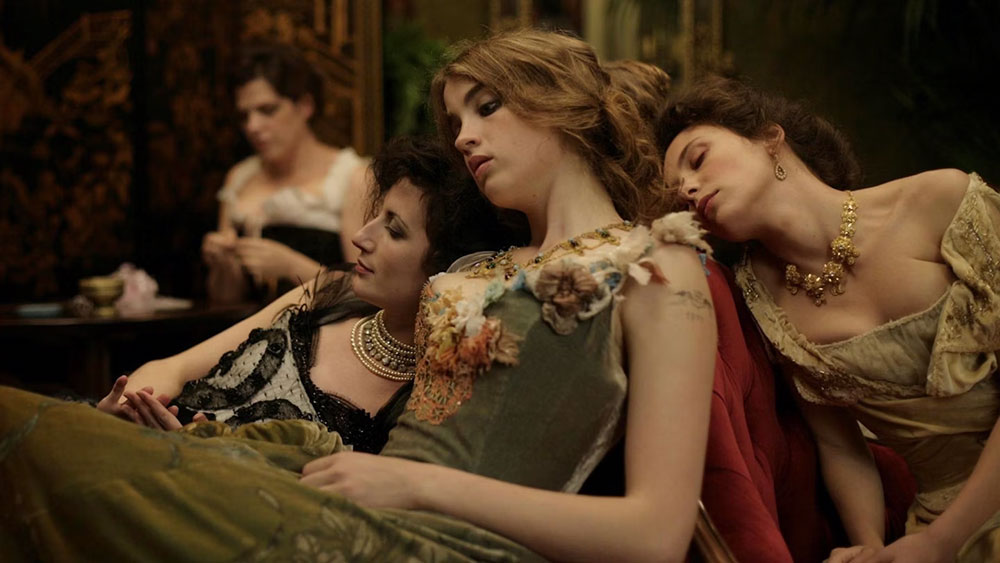This essay appears in “Women, Workers, & Whores on Film” zine with the title “Solidarity in the Realm of the Senses.”
The work of sex is laden with sensuality, grief, and kinship in Bertand Bonello’s House of Tolerance (2011). The film shows the interwoven nightly routines of a group of women working through the dwindling days of a late-1800s Parisian brothel. Pauline (Iliana Zabeth) is taught bluntly which creams and astringents best prepare the body for a session. Clotilde (Céline Sallette) wrestles with the brief dream that her connection with a regular might exceed the session’s frame. Léa (Adèle Haenel) takes on the erotic persona of an eerie clockwork doll. Madeleine’s (Alice Barnole) face is brutally slashed into a permanent smile by a client she trusted; a surreal act of violence that haunts the rest of the film until it is transformed by a final act of collective revenge.
In Bonello’s choreography of the parlor, the camera stays with the women as they move at the languid pace of a midnight dream. In a rare breath of reality from a filmmaker without lived experience trading sex, the clients are the ones without backstory—incidental, interchangeable, and largely uninteresting. We witness tenderness beyond the theater of the trick: two women kiss in the tangled glow of early morning bedsheets in a painterly gesture toward Henri Tolouse-Lautrec’s respectful gaze upon his brothel worker friends of the same era.
Bonello neither idealizes nor vilifies sex work, tracking instead how broader criminalization enables violence against workers while punitive legal restrictions facilitate the exploitation of wage labor. The women in House of Tolerance struggle to pay down ever-redoubling debts to their madam. In a 19th-century state-controlled brothel like the film’s L’Apollonide, sex workers were required to get government paperwork and bi-weekly medical exams, and were legally prohibited from leaving the house’s premises without an escort. “House of tolerance” was an apt moniker for this phenomenon, as it suggested that prostitution would be socially tolerated so long as its practitioners remained within restrictive parameters.
Bonello’s emphasis on the women’s group dynamics in House of Tolerance imbues the film with the force of their solidarity. Their camaraderie is the kind that can only emerge from the shared embodied experience of a form of labor that’s as central to society as it is stigmatized and obscured. After a mortal tragedy rocks the collective, the women weep and dance with each other in a striking funereal scene set to The Moody Blues’ “Nights in White Satin.” House of Tolerance is an ode to how these women survive amidst brutality, stigma, and loss—by holding each other together.
When the ideological tides of the new century turn reactively against decadence, the brothel loses political support and is forced to shutter. The women of L’Apollonide are pushed toward precarity; the red light above the brothel door goes out and we cut to modern-day Paris. A car pulls up and Clotilde exits to join the other working girls by the roadside. Today, post-FOSTA-SESTA, criminalization of once-safer online spaces has forced many workers back into more dangerous street-based labor. As bodily autonomy is further policed under the acceleration of fascism, sex workers are still caught between cycles of de- and re-criminalization. House of Tolerance’s final scene ruptures the container of the period film to forge a chain of solidarity across time.
House of Tolerance screens tonight, April 8, and on April 10, at Anthology Film Archives on 35mm as part of the series “Women, Workers, and Whores on Film.”



